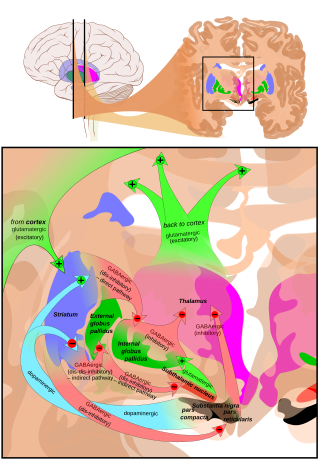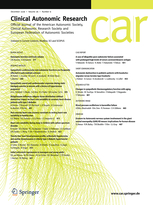
Catatonia is a complex neuropsychiatric behavioral syndrome that is characterized by abnormal movements, immobility, abnormal behaviors, and withdrawal. The onset of catatonia can be acute or subtle and symptoms can wax, wane, or change during episodes. It has historically been related to schizophrenia, catatonia is most often seen in mood disorders. It is now known that catatonic symptoms are nonspecific and may be observed in other mental, neurological, and medical conditions. Catatonia is not a stand-alone diagnosis, and the term is used to describe a feature of the underlying disorder.

Essential tremor (ET), also called benign tremor, familial tremor, and idiopathic tremor, is a medical condition characterized by involuntary rhythmic contractions and relaxations of certain muscle groups in one or more body parts of unknown cause. It is typically symmetrical, and affects the arms, hands, or fingers; but sometimes involves the head, vocal cords, or other body parts. Essential tremor is either an action (intention) tremor—it intensifies when one tries to use the affected muscles during voluntary movements such as eating and writing—or it is a postural tremor, present with sustained muscle tone. This means that it is distinct from a resting tremor, such as that caused by Parkinson's disease, which is not correlated with movement.

A tremor is an involuntary, somewhat rhythmic, muscle contraction and relaxation involving oscillations or twitching movements of one or more body parts. It is the most common of all involuntary movements and can affect the hands, arms, eyes, face, head, vocal folds, trunk, and legs. Most tremors occur in the hands. In some people, a tremor is a symptom of another neurological disorder.

Parkinsonism is a clinical syndrome characterized by tremor, bradykinesia, rigidity, and postural instability. These are the four motor symptoms found in Parkinson's disease (PD), after which it is named, dementia with Lewy bodies (DLB), Parkinson's disease dementia (PDD), and many other conditions. This set of symptoms occurs in a wide range of conditions and may have many causes, including neurodegenerative conditions, drugs, toxins, metabolic diseases, and neurological conditions other than PD.
Movement disorder refers to any clinical syndrome with either an excess of movement or a paucity of voluntary and involuntary movements, unrelated to weakness or spasticity. Movement disorders are synonymous with basal ganglia or extrapyramidal diseases. Movement disorders are conventionally divided into two major categories- hyperkinetic and hypokinetic.

Hyperkinesia refers to an increase in muscular activity that can result in excessive abnormal movements, excessive normal movements, or a combination of both. Hyperkinesia is a state of excessive restlessness which is featured in a large variety of disorders that affect the ability to control motor movement, such as Huntington's disease. It is the opposite of hypokinesia, which refers to decreased bodily movement, as commonly manifested in Parkinson's disease.

The EMBO Journal is a semi-monthly peer-reviewed scientific journal focusing on full-length papers describing original research of general interest in molecular biology and related areas. The editor-in-chief is Facundo D. Batista.
PLOS Genetics is a peer-reviewed open access scientific journal established in 2005 and published by the Public Library of Science. The founding editor-in-chief was Wayne N. Frankel. The current editors-in-chief are Gregory S. Barsh and Gregory P. Copenhaver. The journal covers research on all aspects of genetics and genomics.

Neurology is a weekly peer-reviewed medical journal covering research in neurology. It is published by Wolters Kluwer on behalf of the American Academy of Neurology, of which it is the official journal. It has been edited since April 2020 by José G. Merino.
The Journal of Clinical Psychiatry is a peer-reviewed medical journal that covers clinical psychiatry, especially depression, bipolar disorder, schizophrenia, anxiety, addiction, and attention-deficit/hyperactivity disorder, as well as several other mental disorders. It is the official journal of the American Society for Clinical Psychopharmacology and was established in 1940 as Diseases of the Nervous System, before obtaining its current name in 1979.

Advances in Experimental Medicine and Biology is a peer-reviewed book series. It covers the broad fields of experimental medicine and biology. The series was established in 1967 and is published by Springer Nature. The editors-in-chief are Wim E. Crusio, Haidong Dong, Heinfried H. Radeke, Nima Rezaei, Ortrud Steinlein, and Junjie Xiao.

Movement Disorders is a peer-reviewed medical journal, first published in 1986. The journal focuses on original research relating to neurological movement disorders. The editor-in-chief is A. Jon Stoessl.

Veterinary Record, branded as Vet Record, is a semi-monthly peer-reviewed medical journal covering the field of veterinary medicine. It is published by Wiley on behalf of the British Veterinary Association and is distributed to its members as part of their membership. It was established in 1888.

Joseph Jankovic is Professor at the Baylor College of Medicine, Houston, Texas in the Department of Neurology. He is also the Founder and Director of the Parkinson's Disease Center and Movement Disorders Clinicat Baylor College of Medicine and holds the Distinguished Chair in Movement Disorders in the same institution.
Motor disorders are disorders of the nervous system that cause abnormal and involuntary movements. They can result from damage to the motor system.
A functional neurologic disorder or functional neurological disorder (FND) is a condition in which patients experience neurological symptoms such as weakness, movement disorders, sensory symptoms and blackouts. Symptoms of functional neurological disorders are clinically recognisable, but are not categorically associated with a definable organic disease. The intended contrast is with an organic brain syndrome, where a physiological cause can be identified. Subsets of functional neurological disorders include functional neurological symptom disorder (FNsD), conversion disorder, and psychogenic movement disorder/non-epileptic seizures. The diagnosis is made based on positive signs and symptoms in the history and examination during consultation of a neurologist. Physiotherapy is particularly helpful for patients with motor symptoms and tailored cognitive behavioural therapy has the best evidence in patients with dissociative (non-epileptic) attacks.
Benign hereditary chorea (BHC), also known as benign familial chorea, is a rare autosomal dominant neurogenetic syndrome. It typically presents itself in childhood with isolated chorea, with average to below average intelligence. Unlike other neurogenetic causes of chorea such as Huntington's disease, BHC is not progressive, and not associated with cognitive decline or psychiatric problems in the vast majority of cases.

Clinical Autonomic Research is a bimonthly peer-reviewed medical journal covering research on the autonomic nervous system and its disorders. It was established in 1991 and is published by Springer Science+Business Media. The editors-in-chief are Horacio Kaufmann and Jens Jordan. It is the official journal of the American Autonomic Society and the European Federation of Autonomic Societies.
Pediatric Annals is a monthly peer-reviewed medical journal covering diagnosis and treatment of various pediatric diseases and disorders. It was established in 1972 and is published by Slack.
The Journal of Science and Medicine in Sport (JSAMS) is a monthly peer-reviewed medical journal covering sports science and sports medicine. It is published by Elsevier on behalf of Sports Medicine Australia and the editor-in-chief is Tim Meyer. It was established in 1984 as the Australian Journal of Science and Medicine in Sport, which was a merger of two earlier journals, the Australian Journal of Sports Medicine and Exercise Sciences and the Australian Journal of Sport Sciences.











